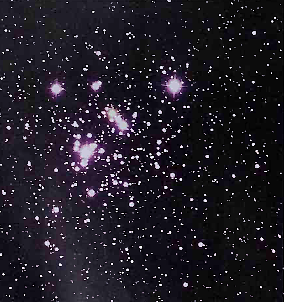What do we know about the stars
The stars appear in our telescopes as points of light, so it might seem that rather little can be learned about them. Among the facts that can be determined about a star are its brightness, which is expressible as the total energy output of the star : its distance, by a variety of techniques: and. from the spectrum of its radiation, its surface temperature and chemical composition.
Two of the above properties, the energy radiated and the surface temperature, can be plotted on a graph (Figure 2.5). When this is done for a large sample of stars, parts of the diagram are densely crowded with points and others are empty. This shows that the surface temperature and rate of energy output (or luminosity) are not independent of each other.

2.5: The Hertzsprung-Russell diagram, showing the empirical relationship of the rate at which a star emits energy tits absolute magnitude) and its spectral class (indicating surface temperature from hoi to cold)
In the temperature-luminosity graph there is a broad band from upper left to lower right, known as the main sequence. Our Sun is located on this band, at the part corresponding to a temperature
of 6000 degrees. Above and to the right of the main sequence are located very luminous giant and supergiant stars. Although these are cooler than the Sun they have much larger surface areas and therefore a higher luminosity. Below the main sequence are small, faint Stan known as white dwarfs. The general features of this temperature - luminosity diagram can be accounted for in the following manner.
Stars are being formed all the time in the Galaxy. They condense under gravity from dense clouds of interstellar gas (Figure 2.6) The early phases of star formation are poorly understood, although it is clear that gravitation.il forces must somehow gain the upper hand in a section of a cloud, as a result of which it starts to collapse on itself.

2.6: A region of star formation (Horsehead Nebula), showing the dark clouds
from which new stars condense, and bright young stars above it
As this process proceeds, the cloud breaks up into smaller units which then progressively contract as well. Within a shrinking cloudlet the gravitational forces increase as the radius decreases. This process ceases only when the internal gas pressure of the cloudlet becomes large enough to balance the gravitational force. At this stage the fragment is already radiating in the infrared as a protostar.
The warm protostar continues to contract, and consequently the temperature and pressure at its centre rise. Eventually the central temperature reaches about 1 degrees, and at this point nuclear reactions begin. The release of energy in these reactions then stabilizes the collapse, because the heat being radiated from the surface is matched by energy released at the centre.
Other fragments in the interstellar cloud go through the same process, with the end result that a cluster of very young stars is formed (Figure 2.7). Not all the gas and dust ends up inside the stars. Some will disperse back into interstellar space and some may condense into planetary systems.

2.7: All stars were probably members of star clusters originally. This is Kappa Crucis. a beautiful jewel-like cluster in the southern sky
When a new star has settled down it has a luminosity and temperature that position it on the main sequence. Its precise location depends only on its mass. At the upper end of the main sequence we find stars twenty, thirty, or even fifty times the mass of the Sun. while at the lower end they may be only half a solar mass.
The energy release mechanism for all main sequence stars is the conversion of hydrogen into helium through a series of nuclear reactions (Figure 2.8). The precise details are less important than the main features of the process. It is of course only the central part of the atom, the nucleus, that is involved in the reaction. In fact, the pressure and temperature in the core of a star are so high that the normal atomic structure of matter has instead been replaced by a mixture of electrons and nuclei.

2.8: The beautiful Orion Sebula. 1600 light years away, is the most prominent gaseous nebula in the sky. The glowing red gas is hydrogen, the major constituent of stars and the commonest element in the universe
At a temperature of 10 degrees the hydrogen nuclei collide sufficiently hard to overcome electrostatic repulsion, and they can then fuse to form the next stable element, helium. This is a
reaction that releases prodigious quantities of energy, because the helium nucleus is 0.65 per cent less massive than the four hydrogen nuclei (protons) that are needed to make it. The 'missing" mass (m) is converted to electromagnetic energy (E). in accordance with the Einstein relation E = mc2 . where c represents the speed of light. Every second, in a star like the Sun. 655 million tonnes of hydrogen are converted to 650 million tonnes of helium: five million tonnes of matter are annihilated to release energy.
Date added: 2022-12-12; views: 664;
